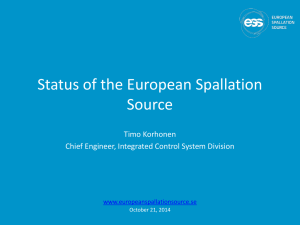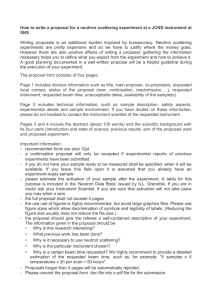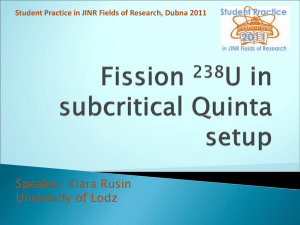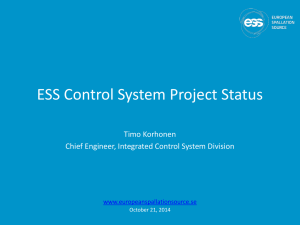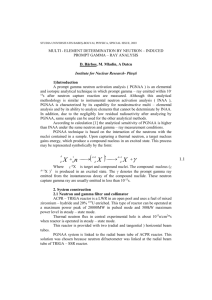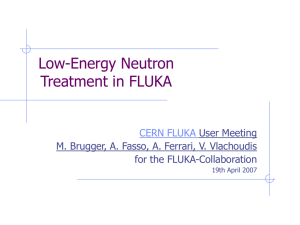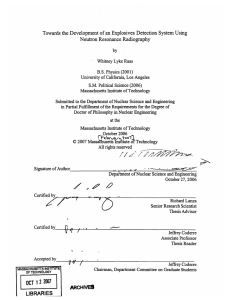2013-01-18-TEMPLATE-ESTBTestBeamProposal
advertisement
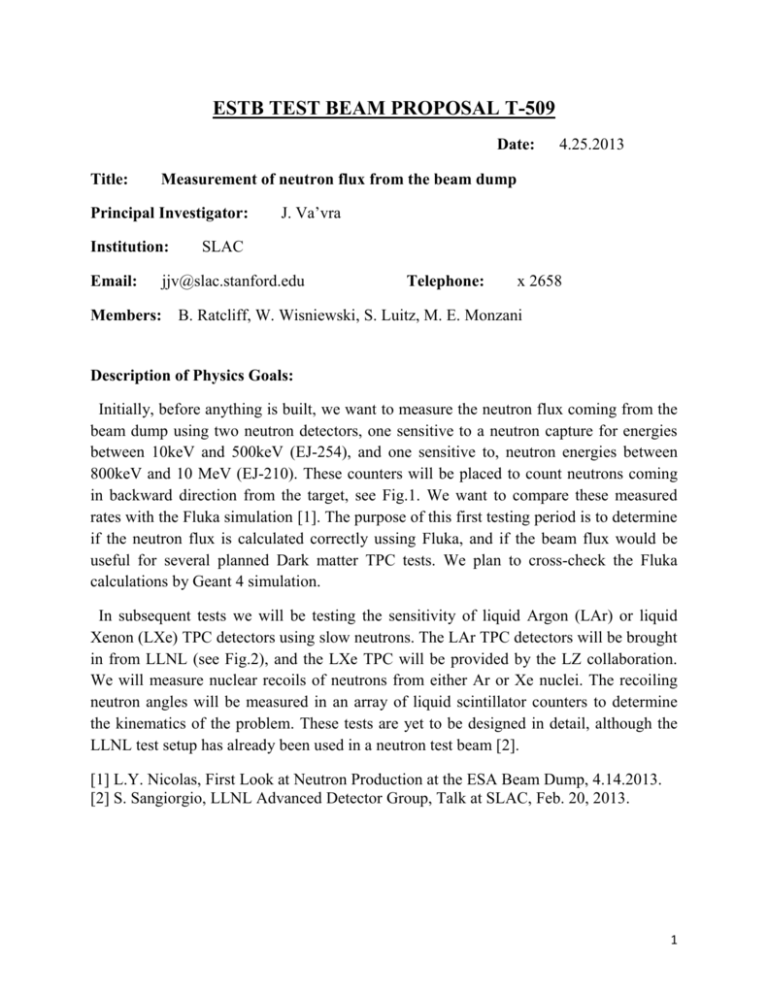
ESTB TEST BEAM PROPOSAL T-509 Date: Title: 4.25.2013 Measurement of neutron flux from the beam dump Principal Investigator: Institution: Email: Members: J. Va’vra SLAC jjv@slac.stanford.edu Telephone: x 2658 B. Ratcliff, W. Wisniewski, S. Luitz, M. E. Monzani Description of Physics Goals: Initially, before anything is built, we want to measure the neutron flux coming from the beam dump using two neutron detectors, one sensitive to a neutron capture for energies between 10keV and 500keV (EJ-254), and one sensitive to, neutron energies between 800keV and 10 MeV (EJ-210). These counters will be placed to count neutrons coming in backward direction from the target, see Fig.1. We want to compare these measured rates with the Fluka simulation [1]. The purpose of this first testing period is to determine if the neutron flux is calculated correctly ussing Fluka, and if the beam flux would be useful for several planned Dark matter TPC tests. We plan to cross-check the Fluka calculations by Geant 4 simulation. In subsequent tests we will be testing the sensitivity of liquid Argon (LAr) or liquid Xenon (LXe) TPC detectors using slow neutrons. The LAr TPC detectors will be brought in from LLNL (see Fig.2), and the LXe TPC will be provided by the LZ collaboration. We will measure nuclear recoils of neutrons from either Ar or Xe nuclei. The recoiling neutron angles will be measured in an array of liquid scintillator counters to determine the kinematics of the problem. These tests are yet to be designed in detail, although the LLNL test setup has already been used in a neutron test beam [2]. [1] L.Y. Nicolas, First Look at Neutron Production at the ESA Beam Dump, 4.14.2013. [2] S. Sangiorgio, LLNL Advanced Detector Group, Talk at SLAC, Feb. 20, 2013. 1 Detailed Description of Experimental Apparatus: - - This initial test position is shown on Fig.1. We will use NIM electronics and LabView to read out a digital oscilloscope. For this test we do not need to install any shielding as we take neutrons coming backward from the target. The initial test will use NIM electronics and a scaler, gated by a delayed strobe, to evaluate the neutron rate as a function of the neutron TOF. It will also use a digital scope read out by LabView for more sophisticated waveform analysis. Figures 3 a&b show the neutron detection efficiency for slow neutrons and fast neutrons. One can see that one deals with very small numbers at a level of ~1% or less. For final tests, we will need riggers to install the shielding blocks, and we need to secure them for earth quaking. We also need to errect a polyethylene neutron beam dump near the ESA wall – see Fig.1. Figure 2 shows the LAr test setup prepared by LLNL. We will provide additional information about these tests later. Preferred Beam Parameters: Beam Parameters Value Particle Type electrons Energy (2-13 GeV) 13 GeV Rep Rate (1-5 Hz nominal, bursts up to 120 Hz) Nominal, can take rate bursts up to 120 Hz Charge per pulse or number of electrons/pulse 104 - 109 electrons/pulse Energy Spread nominal Bunch Length r.m.s. nominal Beam Spot size, x-y, emittance nominal Comments The way secondary particles are produced at ESTB has the inherent risk that the full power beam might be delivered to your experiment. This can happen when the energies between LCLS and the A-line are matched and/or the production target is removed. So suddenly, instead of a single or a few particles it becomes possible that up to around 10^9 particles per bunch might be delivered. Please evaluate the consequences for your experimental apparatus and document them here. Since we can run at full electron intensity per pulse, we do not have a problem with this issue. The experimental setup is well away from the ESA electron beam. 2 Logistics Space Requirements: Fig. 1: Approximate layout of the low energy neutron beam line facility at SLAC. Fig. 2: LLNL LAr TPC setup including electronics and cryogenics [2]. 3 (a) (b) Fig. 3: (a) Calculated neutron detection efficiecy of EJ-254 scintillator for slow neutrons. (b) The same for EJ-410 scintillator. Special Requirements (cooling water, gasses, electricity, magnets, detectors, etc): For initial tests we need almost nothing, only a patch panel connection to bldg 420, where we plan to set up the electronics. Later on, during the neutron physics program, we may need a small magnet to sweep charged particles from the neutron beam. We will also need an experimental area surrounded by shielding blocks, as well routine connections to electrical power. Additional information will be provided later. Estimated installation time: Initial intallation time is very short, basically 1-2 days to install two counters, connect them to a patch panel, link them into a counting house in bldg 420, and verify their operation. During final tests with LAr or LXe, we probably need a few weeks to install, and 2-3 weeks to run the test. The actual times required will depend on further simulations. Duration of Test and Shift Utilization: To measure rates initially we need 2-3 days of stable running time. Desired Calendar dates: Middle-to-Fall of 2013 for initial tests with two counters to verify the Fluka calculation. Spring 2014 for the first test with LAr TPC. 4

